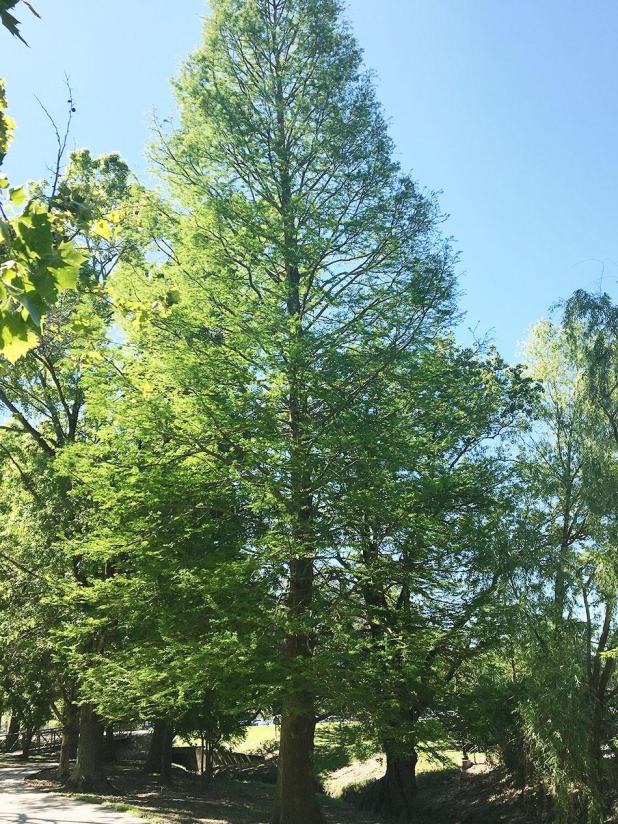
Bald cypress trees are native, deciduous conifers that are long lived and wind resistant.
—LSU AgCenter/Ashley Edwards
Get It Growing: Plant more trees
Let’s talk about the weather. Even if you’re a climate change skeptic, you cannot deny that weather patterns have affected your life in some way in the past five to 10 years.
Here in Louisiana, for example, many experienced unprecedented flooding in 2016. Then, in 2021, we were hit with deep freezes, Hurricane Ida and the third-wettest year on record.
According to the National Oceanic and Atmospheric Admin-istration, 2022 so far has brought nine separate billion-dollar weather and climate disasters to the United States — including extreme drought, heat, tornado outbreaks and hail. July 2022 was the third-hottest year on record for the United States and, on Earth, its sixth hottest year to date.
Today, the carbon dioxide levels in the Earth’s atmosphere are nearly 420 parts per million, the highest they have been for at least the past 800,000 years.
So, what am I getting at here? What can you do about it? As a gardener, you can have a much larger impact on climate change than you may think. According to the USDA’s Arbor Day Foundation, a single mature tree can pull 48 pounds of carbon dioxide out of the atmosphere in one year.
Need more convincing? Here are some facts on the impact trees have on the climate. Trees absorb greenhouse gasses like carbon dioxide from the atmosphere during photosynthesis and store it as a carbon molecule in the plants’ wood, roots and leaves in a process known as carbon sequestration. And in exchange, trees make oxygen that we breathe. We simply could not live without plants.
Trees keep us comfortable with shade, helping us save on energy costs. Trees standing within 60 feet of a home can reduce home energy expenditures and carbon emissions by cooling the house in summer and insulating it from cold winds during the winter. Large trees provide greater energy reductions than small trees. Large trees located on the west side of a house can reduce carbon dioxide emissions almost seven-fold compared to a smaller tree.
Trees also keep our communities cooler. Just take a walk anywhere. If you are like me, you prefer a shaded walk to one in full sun. Lastly, the shade from trees help the soil retain moisture in addition to supporting biodiversity by creating habitats for wildlife species.
With a smattering of tropical storms and hurricanes over the past several years — Gustav, Rita, Harvey, Delta, Laura and, of course, Katrina in 2005 — many homeowners have undoubtedly experienced the damage of falling limbs and trees. I understand the hesitation of planting trees around the home; however, by selecting trees that can withstand hurricane-force winds, you can limit damage with the added benefits for climate change.
When choosing trees to plant, consider their ability to stand up to hurricane-force winds. Trees that have the highest resistance to winds are slow-growing, hardwood trees with deep radial roots and a strong central taproot. Native tree species are a great place to start.
The natural dominant trunk habit in large trees allows them to tolerate strong winds. Scientists at the University of Florida have conducted research that indicates that live oaks, Southern magnolias, bald cypress and sabal palms are excellent choices.
In addition, trees such as American elm, black locust, cow oak, green ash, hackberry, hop hornbeam, hollies, ironwood, nuttall oak, pond cypress, river birch, sweet bay magnolia, sweetgum, sycamore, swamp chestnut oak, spruce pine, tulip tree, willow oak and many other natives have excellent wind resistance.
Some trees to avoid placing near the home that have the least wind resistance are laurel oaks, pecans, water oaks, Chinese elms and, unfortunately, many pines.
If you have plenty of acreage, plant any and all types of tree. Also consider that trees continue storing carbon long after they have fallen. Allow trees to naturally decay in the woods where carbon can be slowly released and taken up by the ground, mushrooms, insects and animals. By keeping the logs and branches on the forest floor, you can provide additional climate benefits while providing new habitat for toads, frogs, salamanders and many other species.
The bottom line is you can make a difference in your landscape to change the world for the better by planting more trees. Any time is a good time to plant trees, but especially the fall and winter. So go for it! Plant more trees, please.
